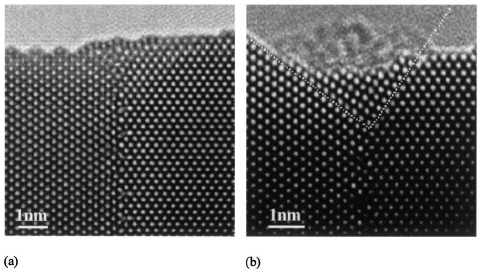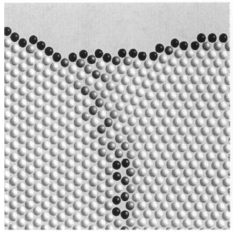|
This book (Practical Electron Microscopy and Database) is a reference for TEM and SEM students, operators, engineers, technicians, managers, and researchers.
|
=================================================================================
HRTEM (high resolution transmission electron microscopy) can be used to not only characterize atomic structures of interfaces and surfaces of polycrystalline materials but also incorporate with simulation methods to evaluate, for instance, the energy of atoms at surfaces, interfaces, and bulk. Radetic et al. [1] had studied the atomic structure at the junction of 90° <110> tilt grain boundaries with the free surface in gold (Au) as shown in Figure 4751a. They proposed that at the {110}/{100} facet, (001) planes from one grain meet (011) planes from the other grain edge to edge, and, as their interplanar spacings are in a ratio of  , the interface is incommensurate in one direction [2]. , the interface is incommensurate in one direction [2].

Figure 4751a. HRTEM images of chevron defects at the intersection of the 90° <110> tilt grain boundary with the free surface [(a),(b)].
Inside the defect in (b), there are stacking faults on alternate layers resulting in a local hcp stacking sequence.
In the simulations of Radetic et al., they found a coherent set of atomic positions and proposed
an interpretation of the defect stability from the energy
distribution in the material, by minimizing the potential energy with
respect to the atomic coordinates. Figure 4751b shows the atomistic simulation of relaxation of the (110)/(001) grain boundary at the free surface. Atoms in the
highest energy positions appear darkest in color, illustrating
the high energy of the original grain boundary and the
lower energy of the chevron defect. Furthermore, the atoms located at the free surface have the highest energy.

Figure 4751b. Atomistic simulation of relaxation of the (110)/(001) grain boundary at the free surface of Au.
[1] T. Radetic, F. Lanc¸ and U. Dahmen, Chevron Defect at the Intersection of Grain Boundaries with Free Surfaces in Au, 89(8), Phy. Rev. Lett., 085502, (2002).
[2] (18) A. P. Sutton, Acta Metall. 36, 1291 (1988).
|

